iPhone vs Android: What are the pros and cons in 2024?
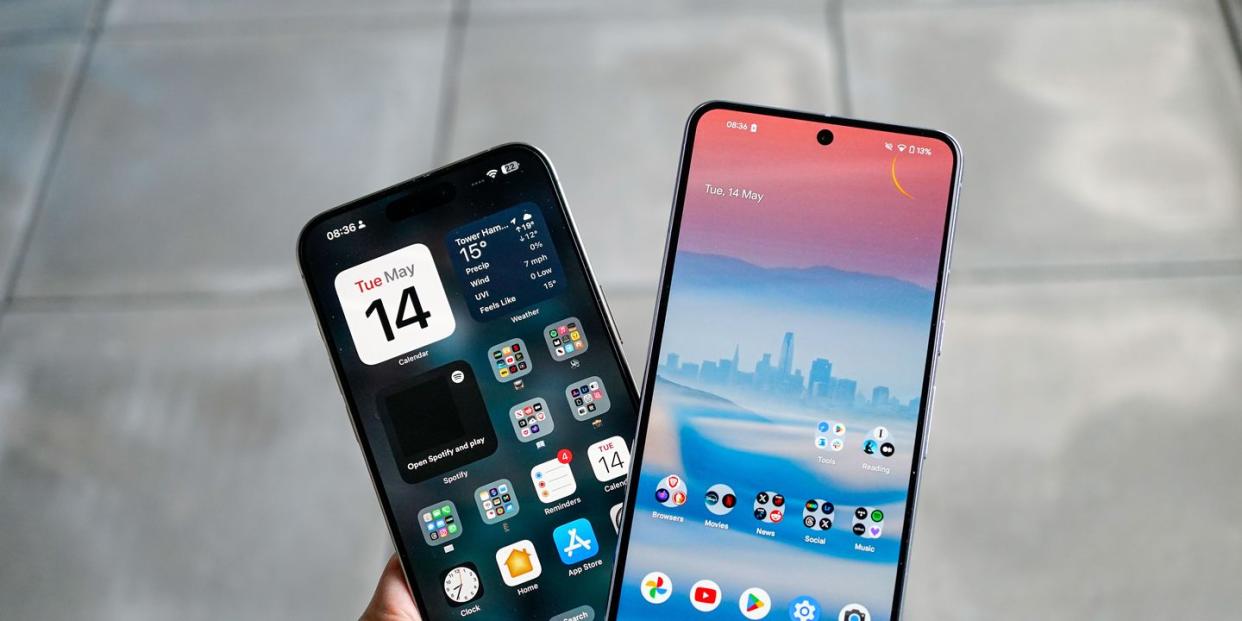
Let’s be honest, the iPhone vs Android debate isn’t all that groundbreaking in 2024. We’ve all been using our smartphones for years, so we have at least a sense of the ecosystem differences and what we prefer. A lot of this can feel like old news.
Nowadays, everything’s more entrenched than it used to be. The “lock-in” effect is real and it isn’t straightforward for anyone to switch devices in either direction. That’s true whether you feel trapped in Apple’s walled garden or unable to let go of exclusive Android features and customisations so you can join the family FaceTime call.
But “switching” is exactly why we’re writing this article. We think it should be possible to leave either the iPhone or Android world to move to the other side, and we want to explain the key differences for those interested in doing so. We will also run through a few of the inherent challenges with moving all your photos, files and data across. Spoiler alert: that’s the hardest bit.
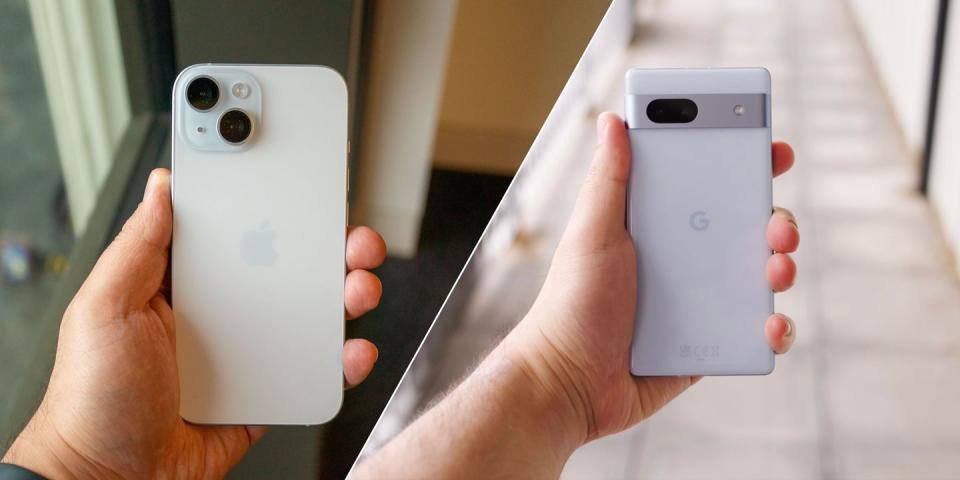
iPhone vs Android: Differences at a glance
According to the Financial Times, Apple now has a vice-like grip on Gen Z in the US, with those born after 1996 making up 34% of all America-based iPhone owners. That compares to just 10% for Samsung.
Social pressure and the need to send “blue bubble” texts on iMessage appear to drive this popularity because, by specs alone there isn’t a huge difference and Android devices are often better value.
This is all reflected, unsurprisingly, when you start to look beyond the States. Samsung and Apple are competitive when it comes to global smartphone market share and Android wins overall when you factor in other brands. We know loads of us can feel pressured to stick to the Apple ecosystem but there are good reasons to consider Android too.
At its simplest, we’d say the main difference is that the iPhone is all about tight integration with other Apple devices and services, while Android is integrated with Google services but also designed for customisability and flexibility. Each approach comes with benefits and tradeoffs.
Here are some of the other main differences:
Operating system: All Android phones run on some variant of Google’s Android operating system, while all iPhones run on Apple’s iOS. When comparing the latest versions, there aren’t as many dissimilarities in navigation and organisation as there used to be, to be honest. But, it is worth remembering that it can take time for the latest upgrades to roll out to all Android devices, and some older devices won’t receive them at all. As a whole, Apple offers longer software support than Android, although that gap is slowly closing.
Customisation vs simplicity: In the most basic terms, you can customise the Android interface more while Apple’s experience is more streamlined and controlled. You can tweak an Android user interface to completely transform it with widgets, launchers, and themes. Sure, this is somewhat possible albeit more challenging on an iPhone. Apple’s phones are clearly made to be uniform across devices.
Phone options: With iPhones, they’re all going to be made and designed by Apple, so there’s no variation or hardware diversity. If you’re in the Android world, you’ll find a wider range of designs and specifications from various manufacturers. If you want to the choice of different screen sizes, specifications, features, price points or the possibility of a folding phone, Android is the way.
Apps: Both iOS and Android have large app stores, but the Google Play Store is almost double the size of the App Store. Apple is much more particular about its vetting process before allowing apps onto its platform, whereas Google allows more freedom for developers which means it gets the latest innovations more quickly. As well as that, some apps only exist on one platform or the other so it’s worth checking if there’s a chance that your favourite is exclusive to only one ecosystem.
Privacy and security: Both systems have only slight variations in security levels, mainly because Android is a more open platform and many devices aren’t running on the latest version with security updates. Apple, meanwhile, emphasises security with biometric authentication features (often Android phones will have these but they’re not certified for authorising payments or banking apps) and frequent security updates. Unless your handset is from an untrusted brand or one you’ve never heard about, though, we’re confident that both operating systems are secure and regularly updated.
iPhone vs Android: Pros and Cons
We’re keen to keep this as simple as possible and have already run through most of the essential different points between the systems. However, it’s worth dwelling on a couple of the pros and cons:
Pros and cons: iPhone
Pros of iPhones
Seamless integration with other Apple tech is a key selling point. Because Apple controls the software and hardware, you end up with a tightly fused setup.
You’ll find a unified experience if you use a Mac, iPad, Apple Watch, Apple TV or AirPods, and the iPhone connects to those with easy AirDrop for file sharing and consistent settings across platforms. If all your family and friends use iMessage and FaceTime too, those are built-in and deeply integrated into the system. You also get a highly secure app store and the Apple approach is ideal for anyone after a clean user experience.
It’s also true that Apple updates its devices for a long time, and has a proven track record of delivering operating system and security updates for many years – the 6s and 6s Plus were supported through a full seven versions of iOS, and Apple’s still pushing out security fixes for those handsets and the original iPhone SE from 2016, even if it’s now considered vintage.
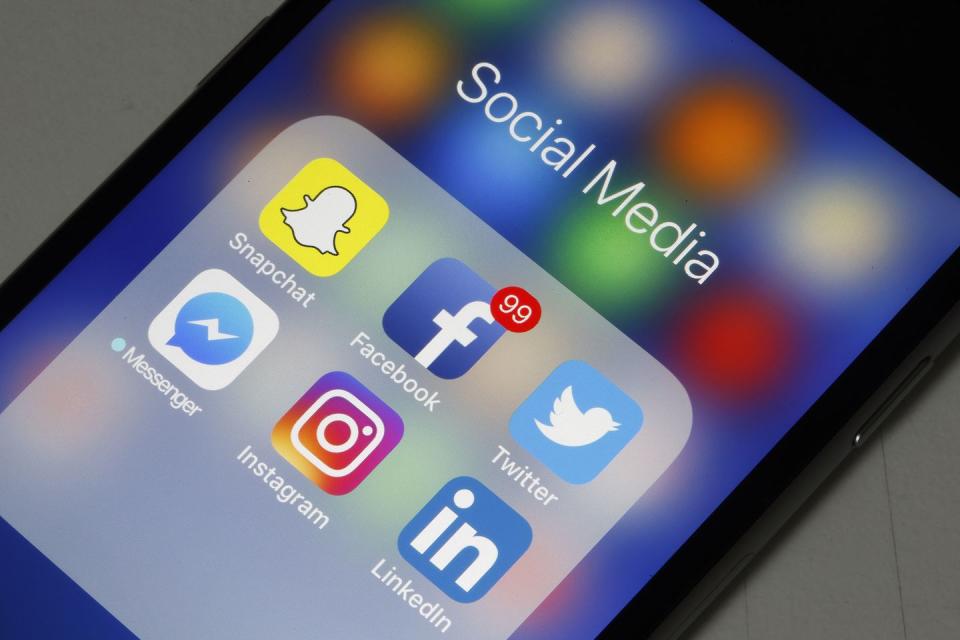
Cons of iPhones
However, it’s notable that the app store is more locked down and doesn’t always have the apps you might want or need. Apple’s phones don’t tend to play well with Android devices, they never feature expandable storage, and it’s more difficult to fix issues by yourself or from a gadget repair shop, as parts often need to come from Apple and may come at extra cost.
Customisation is also limited on iPhone devices, so you’ll struggle if you want to personalise the user interface, install third-party apps outside of the App Store, or tweak system settings. It’s also a bit of a downside that models older than the iPhone 15 use a proprietary Lightning port for charging, which is less convenient than the simpler USB-C port present on all other phones, tablets, laptops and headphones.
We would also highlight that new iPhones tend to come at a higher price than Android rivals, although looking at refurbished phone models is worth it because, as mentioned, older models continue to be supported with software updates.
Pros and cons: Android
Pros of Android phones
The big benefit of Android can be summed in with the word “open” as that’s what the experience feels like. It’s a more open ecosystem of different devices and it’s even more open on some devices in terms of storage because you’ll be able to find options that take memory cards.
Customisation is another huge draw to Android because you can make adjustments to suit your tastes — you can change the size and shape of the app icons, change the colour scheme across the whole device to match your wallpaper and change the look of the always-on display.
As well as being more customisable, Android phones are easier and cheaper to repair. Some, like the Fairphone 5, are even user-repairable. You can take an Android phone to any phone repair shop and they should be able to replace the screen or fix your charging issues.
When longtime iPhone users try Android phones, they find there are similarities in the software they didn’t expect, along with better features that they missed out on. As much as we like iOS, the notification management on Android seems better.
There are many more routes to jazzing up the whole interface, if you want to, and a wide range of widgets, custom launchers and themes that don’t exist in the Apple world. That goes along with the more open store and access to apps beyond the Play Store.
You’re also not going to feel as locked in and there’s more hardware diversity from different manufacturers. A good example is foldable displays because Android is currently the only operating system to offer them. The Samsung Galaxy Z Flip 5 is a palm-sized flip phone that folds out into a regular handset, while the Google Pixel Fold is a smartphone that uses a flexible display to transform into a mini-tablet.
As well as that, Android has more choices for a range of budgets. Like iPhones, the top-level flagships can cost £1,000 or more. But you can also find Android handsets like the Nokia G42 for less than £200, or even less than £100 such as the Motorola E13.
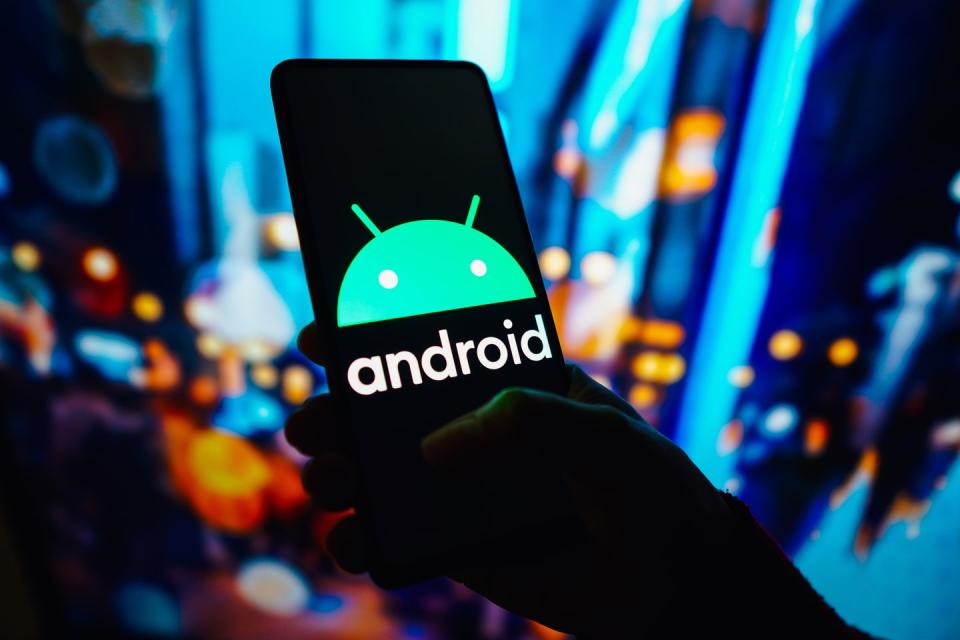
Cons of Android phones
As good as the open approach is, it’s also resulted in a fragmented ecosystem. You’ll find there are loads of different brands releasing a variety of devices with varying hardware and software specs. You won’t always land on the latest Android version and it’s not unusual to experience inconsistency in the user experience and annoying delays to software updates.
Heard about bloatware? Yes, it’s also not unusual for Android models to come stuffed with apps you didn’t want, and this can happen on budget or premium models. Our tip to avoid this would be to stick with one of the best Google Pixel phones.
There’s of course a perception that Android security isn’t quite as tight as Apple, but that comes down to several other factors including the device you choose and where you download your apps from. We think they’re comparable, but it is true that most Android phones don’t have the sophisticated biometrics of Apple’s FaceID recognition. That’s certified for payments and unlocking banking apps, unlike a more simple face unlock system.
iPhone vs Android: Which is better value for money?
On the face of it, this question appears to have a fairly simple answer – it’s easy to pick up budget Android handsets that run laps around the cheapest iPhone on the spec sheet. If you compare the Nothing Phone (2a) and the ageing 3rd-gen iPhone SE, it seems clear that the newer rival delivers more advanced hardware for a lower price.
But, the perception of value does depend on how you compare the base price to the longevity of devices. As we’ve mentioned, the iPhone gets software and security support for longer, and while Google and Samsung are stepping up in this area with lengthy system update promises, those aren’t as straightforward as looking at Apple’s track record.
Right now, we highly recommend the Google Pixel 8 as the top Android flagship and the iPhone 15 as a terrific handset for the Apple ecosystem. On a budget, you’ll find the Google Pixel 8a is a fantastic device, especially for its camera and speedy software updates. However, we’d also be confident recommending a refurbished iPhone like the iPhone 13 or iPhone 14, that’ll continue to be supported long into the future. If in doubt, always consider going refurbished for even lower prices.
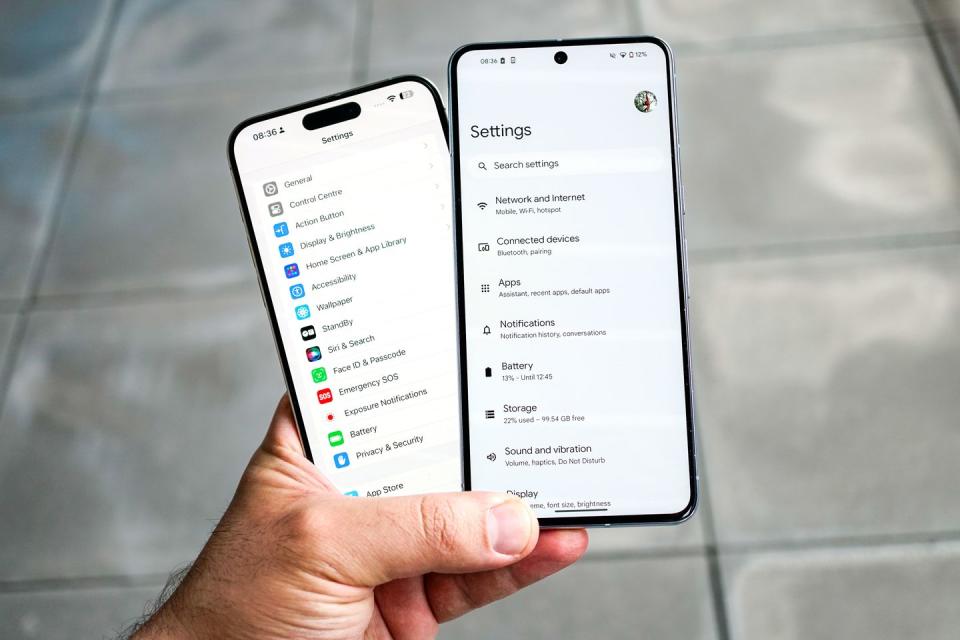
iPhone vs Android: Exclusive features explained
It’s easy to get lost in the weeds when running through the exclusive features available to each platform, but we’ll cover a couple of the main ones to give you the gist of it.
On iPhones, iMessage is completely exclusive and never on Androids, you get AirPlay 2 to cast over to a wide range of speakers over wifi, there’s FaceTime for voice and video calls to Apple devices, SharePlay so that you can watch something in sync with your friends. And there’s also built-in Siri, in case Apple’s voice assistant matters to you. Of course, we could go on, but these are some of the highlights.
When it comes to Android, you’ll find there’s no limitation to creating multiple users on one device (something Apple prohibits), you’ll get quick access to the Google Assistant, there’s more home screen, widget and font customisation, and stylus support on many Android phones including the Samsung Galaxy S24 Ultra and Galaxy Z Fold5. Several Android devices feature super fast charging that takes less than 30 minutes, like the OnePlus 12 and the Oppo Find X7. Android features like Google Fast Pair are worth mentioning, which connects Bluetooth devices as soon as you turn them on and there are also a whole load of smart Pixel-only features we love, including call screening, live translations, and AI-powered photo modes.
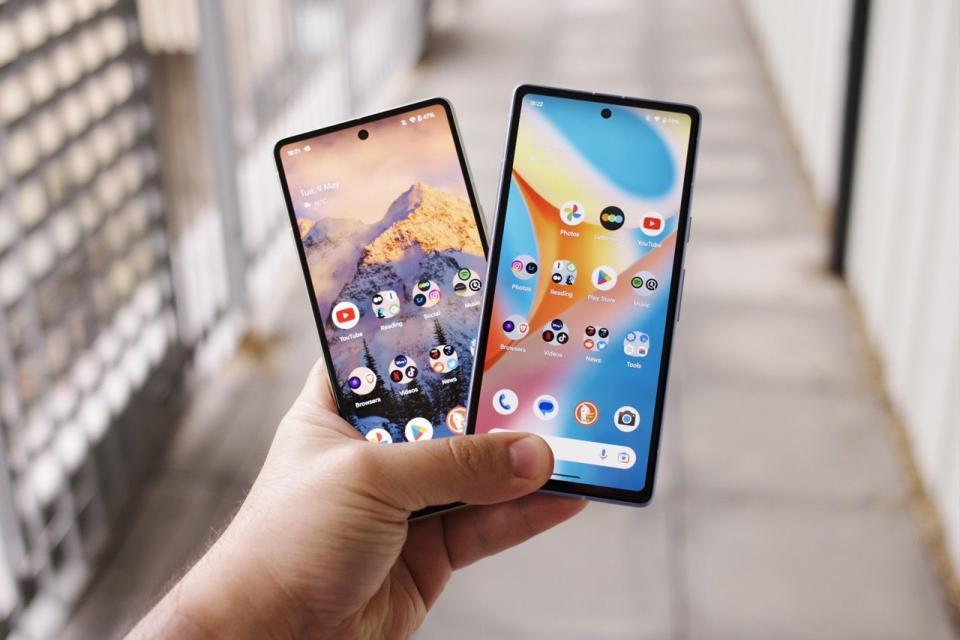
iPhone vs Android: Is it easy to switch?
The quick answer? No, it’s not easy to switch between an iPhone and Android.
If you’re still here, we do want to say that it is possible but you’re going to need to be prepared to do some serious legwork.
If you’re going from iOS to Android, you’re going to need to get all your data off Apple-exclusive locations like Apple Photos and iCloud and move it across to cross-platform solutions, and that could be very time-consuming. The same will be true if you’re moving a massive photo library, contacts list, message history or more over from an Android phone to an iPhone. You’re going to need to be ready to sift through what you’ve got, and acknowledge that you may not be able to move it seamlessly.
The more “locked in” you are either way, the harder it’ll be. If you mostly communicate via external messaging apps, don’t have lots of photos to move and are happy keeping your video calls in Meet, WhatsApp or Zoom rather than FaceTime, you won’t have as much trouble.
You may also find certain apps aren’t on both devices, though. For example, our favourite iPhone podcast app, Overcast, isn’t available for Android, so you'd need to go through the process of migrating to a cross-platform option, like Pocket Casts.
There are helpful guides from Android on how to move from an iOS device, and Samsung has an iPhone to Android walkthrough too. The Samsung SmartSwitch app can help, as can connecting your old and new devices with a cable during the setup process. Apple also offers a Move to iOS app that’s in the Google Play Store, and this can help a lot if you’re heading in the other direction.
Don’t say we didn’t warn you, though. No matter what approach you take, there’s going to be the risk of losing data you didn’t realise couldn’t be carried over. It’s a perilous endeavour.
iPhone vs Android: Verdict
Which platform is better? Well, it’s going to depend on what other devices you have and use, what you value in a smartphone and whether you’re prepared to embark on a tricky switching process.
Broadly, though, we recommend the iPhone and Apple ecosystem to those who value simplicity and a seamless, integrated experience with other Apple products. Maybe you’ve got a Mac, iPad and an Apple TV but aren’t on an iPhone yet? You may find it simplifies things far more than you expected.
On the other hand, we recommend Android for those after a wider range of customisation options and hardware diversity from multiple manufacturers. If you’ve got an iPhone and find yourself avoiding Apple’s stock apps and preferring Google Photos, Chrome, Brave or Gmail, or if you started a smart home setup in an app like Amazon Alexa, Samsung SmartThings or Google Home, you’re primed for the move already and will find the experience intuitive.
It may not be the most satisfying conclusion, but the reality is that there isn’t a simple answer to which is better for you. Run through the pros and cons, take stock of the exclusive features you use or ones you skip, along with any hardware features you value, and you should be able to piece together which setup suits you best.
You Might Also Like

